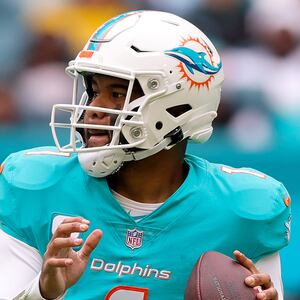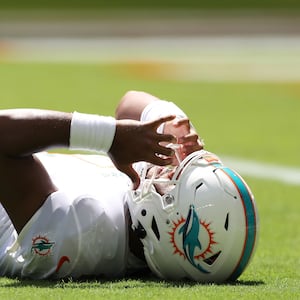Inside a small office in the New Lab Innovation Complex at the Brooklyn Navy Yard this past February, the thunderous sounds of a wrestling match could be heard bouncing off the walls of an otherwise calm workspace. I walked in and saw two heavyweights—each in full-body motion capture gear, locked in a clinch on wrestling mats spread across the center of the office. To the side of the room, next to a dry erase board scrawled with a web of potential combat situations, were two video game designers from New York University developing a promotional video game that focuses on the types of freestyle and Greco-Roman wrestling seen in high schools and colleges across North America. The video game is actually supposed to promote a specific product: a futuristic looking softshell helmet that sat on a drafting table at the other end of the room. It’s less of the brightly colored foam headgear one imagines in a varsity wrestling match than it is the headgear of a Celtic warrior, redesigned for the 21st century.
Contact sports have swelled into a billion-dollar market—but in spite of that growth (or perhaps because of it), they are also a focal point in a larger discussion over the risks of head injuries and concussions in young people. In 2018 alone, nearly 450,000 people were treated for sports-related head injuries at U.S. hospitals, according to the U.S. Consumer Product Safety Commission. From 2010 to 2016, about 283,000 children were brought to the emergency room each year due to sports and recreation–related traumatic brain injuries, according to the Centers for Disease Control and Prevention.
“So much of this trauma is preventable with the right equipment,” Mario Mercado, an entrepreneur and former New York University wrestling coach, told The Daily Beast. “We undeniably need to address the severe rate of concussions and other head traumas, but contact sports are a part of the American way of life. Kids need this.”
ADVERTISEMENT

Mercado wants to take this challenge head-on—literally. His company, BATS-TOI, based in Brooklyn, New York and founded in July 2016, has developed a patented multi-sport headgear that uses a new kind of 3D printing approach to provide heightened protection against concussion-inducing impacts.
Mercado himself wrestled throughout most of his youth in New York City, and went on to compete for Syracuse University in the late ’90s. “My body, and that of so many of the athletes I know, has been smashed by years of abuse,” he said. “Most of that time we weren’t really addressing the issues of concussions the way we are today.”
He became especially concerned about the cumulative effects of such injuries in 2015 while coaching grapplers at NYU. “I kept seeing my guys getting concussed and experiencing debilitating collisions at an unacceptable rate,” he said. “I figured that this was a problem I could help solve.”
While a graduate student studying sports management at NYU and then later at Columbia University, Mercado developed a concept for an impact-resistant softshell headgear that could be used in a variety of sports, either as a stand alone piece of equipment, or as an insert. Nikil Gupta, an aerospace engineering professor at NYU, helped Mercado develop a working prototype using 3D printing, which helped make the end-result cheaper than any of the injection molded helmets currently on the market.
But the cost to make the headgear remained high. BATS-TOI decided to partner with HP (formerly Hewlett-Packard) and make use of its patented multijet fusion (MJF) process, which can customize the “Mercado” headgear to fit any head shape without needing an entirely new injection mold for each individual. A similar process was recently deployed by KAV to make made-to-order bicycle helmets.
But the BATS-TOI team wants to go further than just making a more individualized helmet. It wants to figure out what goes on in a concussion at a more granular level—by looking at what’s going on inside the helmet.
In 2020, BATS-TOI partnered with NOMODiagnostics, a Boston-based startup that produces medical wearables focused on concussion detection and prevention (BATS-TOI has been a minority stakeholder in NOMO since December 2017). NOMO was founded by former Columbia University Medical Center neurologist James Noble, who noticed that the majority of his patients were coming to him with previously undiagnosed concussions, and missing out on early treatment. As a result, many were coming to him with traumatic brain disease that had progressed too far for treatment.
Noble had an idea for how to fix this. Quantitative electroencephalograms, or qEEGs, are a gold standard in brain medicine to measure electrical activity in the brain and gauge brain activity and health, representing the data visually as waves and ascribing numerical values based on each wave’s structure, frequency, and variance.
It’s very valuable work, but traditional qEEG devices require wearers to have their head wrapped, and systems used to take longer readings (like overnight to monitor the patient’s sleep) require the electrodes be held in place with adhesives for data to be collected.
Noble and his team came up with an idea to shrink the qEEG system down to a size that could be embedded into headgear and headbands and provide early alert when injury occurs. NOMO’s system uses four pronged electrodes as opposed to the flat, circular sensors. The sensors in the headgear accurately detect brain waves in real-time, and calculate the force of acceleration on the body to give a more holistic view of the brain’s activity and condition during use.

The latest version of BATS-TOI’s headgear, the Mercado II, will allow users to track, analyze, and catalog up to 17 hours of brain activity and impact forces on the body. In the spring of 2021, male and female combatants of all types—collegiate wrestlers, amateur and professional MMA fighters, and kickboxers—wore a prototype of ‘The Mercado’ with the qEEG sensor system in place. Their brain wave activity was recorded over a combined 150 hours of data capture and analysis. The biosignal and video data were analyzed, indicating that NOMO’s technology can in fact be used to monitor brain health through an algorithm in real-time.
I had the chance to try on the Mercado II, which has the look and feel of a futuristic rugby and football helmet crossover. It has a tight hold on the head. Looking in the mirror, I felt like I was about to walk onto a battlefield in Halo. Even with a polished finish, it looks more aggressive than the average piece of sportsgear.
Most importantly, however, I saw that it really does work. A knuckle sandwich to my head with my own fist went virtually unregistered. A stiff Judo throw from Mercado himself for good measure only underscored this. I felt that, were I in an MMA fight and I receive a blow to the head while wearing it, I’d be able to fight on.
Mercado and the BATS-TOI team are far from alone in their mission. Connecticut-based startup Q30, for example, created a 3D printed cervical collar that applies light pressure to the sides of the neck to increase blood volume in the brain’s venous structures and reduce harmful internal movement that can cause brain injury. Back in 2013, sports equipment retail giant Riddell debuted InSite, an external impact sensor to catalog thousands of different points of external impact on the helmet (though it can’t measure what’s happening inside the brain).

The problem with these products, Steltzer told The Daily Beast, is that they address only discrete aspects of traumatic head injuries in sports, not the whole thing. NOMO’s research determined that the impact sensors being used by Riddell and others in their protective headgear are good for measuring movement around the brain, but not brain health.
In June 2022, the Mercado II was named the official headgear of the National Federation of High Schools (NFHS), and also received approval from the NCAA for use in collegiate sports BATS-TOI’s business skyrocketed, and the company received its first few thousand orders. But FDA approval of the qEEG-integrated version is still approximately 18 months away, according to several doctors familiar with the process who spoke to The Daily Beast. Steltzer says that the current phase of this process is about teaching their qEEG algorithm to detect a concussion autonomously, and the only way for NOMO to program it to do so is by having data from known head injuries, confirmed by medical professionals. To acquire this data, NOMO’s U.K. team has begun a clinical study with Leeds Beckett University and the Rugby Football League. Stateside, BATS-TOI is currently working with leading members of Mercado’s martial arts community to collect concussion data during full combat simulations.
But there’s reason to be cautious about relying so heavily on qEEG data to understand head injuries. Bonnie Wong, a neurologist who specializes in epilepsy at SUNY Downstate Medical Center in Brooklyn, told The Daily Beast that BATS-TOI and NOMO are up against a major challenge: the quality of the data they collect. “With EEG, the brain signals are amplified over a million times, but it also amplifies any muscle artifact [false readings due to other types of biosignals] that you may have, like chewing. And then there’s the issue of contact, getting around different types of hair, and sweat, which also can contribute to data quality issues.”

Steltzer countered that the use of dry electrodes by NOMO bypasses these issues and reduces interference. NOMO’s team also said that, since the company is focusing on impact injuries only, the data it collects doesn’t need to read from the deep structures of the brain, or with the same level of fidelity as with other applications of EEGs, like diagnosing epilepsy.
Stephen Xenakis, a psychiatrist with an expertise on blast concussions and combat trauma (and a retired brigadier general in the U.S. Army), thinks the Mercado II could play a key role in better understanding PTSD. Xenakis, who has been working with EEG in clinical settings for over twenty years, urged Pentagon leadership to develop EEG technology back in 2007 in order to diagnose and effectively monitor traumatic brain injuries.
Steltzer confirmed that NOMO has received a great deal of interest from U.S. armed forces. The company has received funding from the National Security Innovation Network for a military-grade prototype, and has worked with the United States Army Aeromedical Research Laboratory at Fort Rucker on putting NOMO’s designs into a combat helmet.
Right now, however, Mercado’s team is most immediately focused on raising more funding for BATS-TOI, and hopes to put a NOMO-integrated version of the Mercado II on shelves by the end of next year.
At the company’s crash pad-ladened testing facility in Brooklyn, another colossal thud emanated from the center of the room. It’s the kind of sound that makes your jaw clench, as if you’re certain of the injury you just overheard. All members of the team turned to see a young wrestler, pinned underneath his opponent after a jarring takedown, who looked up at Mercado with a smile to indicate he was OK. Mercado encouraged the two to fight on, reciting a French phrase that commands someone to “fight on”, attributed to Napoleon Bonaparte when his troops faced opposition: “Bats-toi!”








